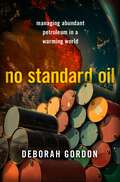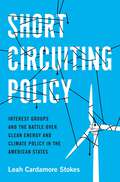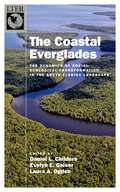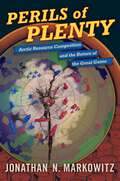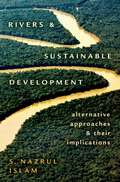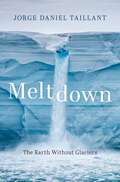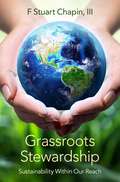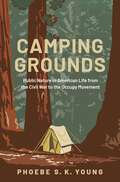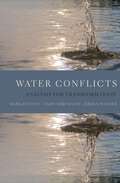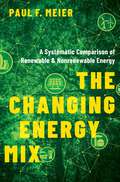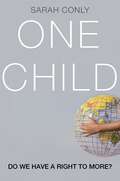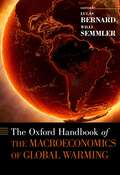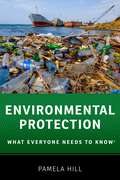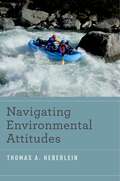- Table View
- List View
No Standard Oil: Managing Abundant Petroleum in a Warming World (Carnegie Endowment for International Peace)
by Deborah GordonIn No Standard Oil, environmental policy expert Deborah Gordon examines the widely varying climate impacts of global oils and gases, and proposes solutions to cut greenhouse gas emissions in this sector while making sustainable progress in transitioning to a carbon-free energy future. The next decade will be decisive in the fight against climate change. It will be impossible to hold the planet to a 1.5o C temperature rise without controlling methane and CO2 emissions from the oil and gas sector. Contrary to popular belief, the world will not run out of these resources anytime soon. Consumers will continue to demand these abundant resources to fuel their cars, heat their homes, and produce everyday goods like shampoo, pajamas, and paint. But it is becoming more environmentally damaging to supply energy using technologies like fracking oil and liquefying gas. Policymakers, financial investors, environmental advocates, and citizens need to understand what oil and gas are doing to our climate to inform decision-making. In No Standard Oil, Deborah Gordon shows that no two oils or gases are environmentally alike. Each has a distinct, quantifiable climate impact. While all oils and gases pollute, some are much worse for the climate than others. In clear, accessible language, Gordon explains the results of the Oil Climate Index Plus Gas (OCI+), an innovative, open source model that estimates global oil and gas emissions. Gordon identifies the oils and gases from every region of the globe-along with the specific production, processing, and refining activities-that are the most harmful to the planet, and proposes innovative solutions to reduce their climate footprints. Global climate stabilization cannot afford to wait for oil and gas to run out. No Standard Oil shows how we can take immediate, practical steps to cut greenhouse gas emissions in the crucial oil and gas sector while making sustainable progress in transitioning to a carbon-free energy future.
No Standard Oil: Managing Abundant Petroleum in a Warming World (Carnegie Endowment for International Peace)
by Deborah GordonIn No Standard Oil, environmental policy expert Deborah Gordon examines the widely varying climate impacts of global oils and gases, and proposes solutions to cut greenhouse gas emissions in this sector while making sustainable progress in transitioning to a carbon-free energy future. The next decade will be decisive in the fight against climate change. It will be impossible to hold the planet to a 1.5o C temperature rise without controlling methane and CO2 emissions from the oil and gas sector. Contrary to popular belief, the world will not run out of these resources anytime soon. Consumers will continue to demand these abundant resources to fuel their cars, heat their homes, and produce everyday goods like shampoo, pajamas, and paint. But it is becoming more environmentally damaging to supply energy using technologies like fracking oil and liquefying gas. Policymakers, financial investors, environmental advocates, and citizens need to understand what oil and gas are doing to our climate to inform decision-making. In No Standard Oil, Deborah Gordon shows that no two oils or gases are environmentally alike. Each has a distinct, quantifiable climate impact. While all oils and gases pollute, some are much worse for the climate than others. In clear, accessible language, Gordon explains the results of the Oil Climate Index Plus Gas (OCI+), an innovative, open source model that estimates global oil and gas emissions. Gordon identifies the oils and gases from every region of the globe-along with the specific production, processing, and refining activities-that are the most harmful to the planet, and proposes innovative solutions to reduce their climate footprints. Global climate stabilization cannot afford to wait for oil and gas to run out. No Standard Oil shows how we can take immediate, practical steps to cut greenhouse gas emissions in the crucial oil and gas sector while making sustainable progress in transitioning to a carbon-free energy future.
Short Circuiting Policy: Interest Groups and the Battle Over Clean Energy and Climate Policy in the American States (Studies in Postwar American Political Development)
by Leah Cardamore StokesIn 1999, Texas passed a landmark clean energy law, beginning a groundswell of new policies that promised to make the US a world leader in renewable energy. As Leah Stokes shows in Short Circuiting Policy, however, that policy did not lead to momentum in Texas, which failed to implement its solar laws or clean up its electricity system. Examining clean energy laws in Texas, Kansas, Arizona, and Ohio over a thirty-year time frame, Stokes argues that organized combat between advocate and opponent interest groups is central to explaining why states are not on track to address the climate crisis. She tells the political history of our energy institutions, explaining how fossil fuel companies and electric utilities have promoted climate denial and delay. Stokes further explains the limits of policy feedback theory, showing the ways that interest groups drive retrenchment through lobbying, public opinion, political parties and the courts. More than a history of renewable energy policy in modern America, Short Circuiting Policy offers a bold new argument about how the policy process works, and why seeming victories can turn into losses when the opposition has enough resources to roll back laws.
SHORT CIRCUITING PAPD C: Interest Groups and the Battle Over Clean Energy and Climate Policy in the American States (Studies in Postwar American Political Development)
by Leah Cardamore StokesIn 1999, Texas passed a landmark clean energy law, beginning a groundswell of new policies that promised to make the US a world leader in renewable energy. As Leah Stokes shows in Short Circuiting Policy, however, that policy did not lead to momentum in Texas, which failed to implement its solar laws or clean up its electricity system. Examining clean energy laws in Texas, Kansas, Arizona, and Ohio over a thirty-year time frame, Stokes argues that organized combat between advocate and opponent interest groups is central to explaining why states are not on track to address the climate crisis. She tells the political history of our energy institutions, explaining how fossil fuel companies and electric utilities have promoted climate denial and delay. Stokes further explains the limits of policy feedback theory, showing the ways that interest groups drive retrenchment through lobbying, public opinion, political parties and the courts. More than a history of renewable energy policy in modern America, Short Circuiting Policy offers a bold new argument about how the policy process works, and why seeming victories can turn into losses when the opposition has enough resources to roll back laws.
The Coastal Everglades: The Dynamics of Social-Ecological Transformation in the South Florida Landscape (The Long-Term Ecological Research Network Series)
by Daniel L. Childers, Evelyn E. Gaiser, and Laura A. OgdenThe Coastal Everglades presents a broad overview and synthesis of research on the coastal Everglades, a region that includes Everglades National Park, adjacent managed wetlands, and agricultural and urbanizing communities. Contributors for this volume are all collaborators on the Florida Coastal Everglades Long-Term Ecological Research Program (FCE LTER). The FCE LTER began in 2000 with a focus on understanding key ecosystem processes in the coastal Everglades, while also developing a platform for and linkages to related work conducted by an active and diverse Everglades research community. The program is based at Florida International University in Miami, but includes scientists and students from numerous other universities as well as staff scientists at key resource management agencies, including Everglades National Park and the South Florida Water Management District. Though the Everglades landscape spans nearly a third of the State of Florida, the focus on the coastal Everglades has allowed the contributors to examine key questions in social-ecological science in the context of ongoing restoration initiatives. As this book demonstrates, the long-term research of the FCE LTER has facilitated a better understanding of the roles of sea level rise, water management practices, urban and agricultural development, and other disturbances, such as fires and storms, on the past and future dynamics of this unique coastal environment. By comparing properties of the Everglades with other subtropical and tropical wetlands, the book challenges ideas of novelty while revealing properties of ecosystems at the ends of gradients that are often ignored. It also provides insights from, and encouragement for, long-term collaborative studies that inform resource management in similarly threatened coastal wetland landscapes.
Perils of Plenty: Arctic Resource Competition and the Return of the Great Game
by Jonathan N. MarkowitzAmong scholars who focus on the politics of natural resources, conventional wisdom asserts that resource-scarce states have the strongest interest in securing control over resources. Counterintuitively, however, in Perils of Plenty, Jonathan N. Markowitz finds that the opposite is true. In actuality, what states make influences what they want to take. Specifically, Markowitz argues that the more economically dependent states are on resource extraction rents for income, the stronger their preferences will be to secure control over resources. He tests the theory with a set of case studies that analyze how states reacted to the 2007 exogenous climate shock that exposed energy resources in the Arctic. Given the dangerous potential for conflict escalation in the Middle East and the South China Sea and the continued shrinkage of the polar ice cap, this book speaks to a genuinely important development in world politics that will have implications for understanding the political effects of climate change for many years to come.
PERILS OF PLENTY C: Arctic Resource Competition and the Return of the Great Game
by Jonathan N. MarkowitzAmong scholars who focus on the politics of natural resources, conventional wisdom asserts that resource-scarce states have the strongest interest in securing control over resources. Counterintuitively, however, in Perils of Plenty, Jonathan N. Markowitz finds that the opposite is true. In actuality, what states make influences what they want to take. Specifically, Markowitz argues that the more economically dependent states are on resource extraction rents for income, the stronger their preferences will be to secure control over resources. He tests the theory with a set of case studies that analyze how states reacted to the 2007 exogenous climate shock that exposed energy resources in the Arctic. Given the dangerous potential for conflict escalation in the Middle East and the South China Sea and the continued shrinkage of the polar ice cap, this book speaks to a genuinely important development in world politics that will have implications for understanding the political effects of climate change for many years to come.
Rivers and Sustainable Development: Alternative Approaches and Their Implications
by S. Nazrul IslamRivers are a vital component of ecology-the earth's hydrological cycle depends on them. However, across the world, rivers are under stress and even in crisis. With rising populations, the demand for river water is increasing. Many rivers fail to reach the sea because of excessive withdrawal of water, and many other rivers are heading toward the same fate. Conflicts over river water are increasing, and climate change is making matters worse. River policies pursued so far are often aggravating these challenges rather than solving them. Yet, sustainable development requires healthy rivers. Urgent change in the approach and policies toward rivers is therefore required. In this book, Nazrul Islam points to the ways in which river policies need to change to ensure sustainable development. He offers a new conceptual framework, using such concepts as the Commercial and Cordon approaches to rivers and their opposite, the Ecological and Open approaches. He shows that while the former generally work against sustainability, the latter are conducive to sustainable development. The book illustrates this reality by drawing upon worldwide experience regarding rivers. Going forward, river policies therefore should be based on Ecological and Open approaches. Islam argues further that the use of the new conceptual framework offered in this book can help to connect the river related discussion of experts with that of activists. It can thus help to move the discussion of river policies from the narrow confines of experts to the wider arena of the public, who should have a greater role in formulation of river policies in order to safeguard public interests and ensure sustainability. The book serves as a valuable guide for those interested in learning about river policy changes necessary to promote sustainable development.
Rivers and Sustainable Development: Alternative Approaches and Their Implications
by S. Nazrul IslamRivers are a vital component of ecology-the earth's hydrological cycle depends on them. However, across the world, rivers are under stress and even in crisis. With rising populations, the demand for river water is increasing. Many rivers fail to reach the sea because of excessive withdrawal of water, and many other rivers are heading toward the same fate. Conflicts over river water are increasing, and climate change is making matters worse. River policies pursued so far are often aggravating these challenges rather than solving them. Yet, sustainable development requires healthy rivers. Urgent change in the approach and policies toward rivers is therefore required. In this book, Nazrul Islam points to the ways in which river policies need to change to ensure sustainable development. He offers a new conceptual framework, using such concepts as the Commercial and Cordon approaches to rivers and their opposite, the Ecological and Open approaches. He shows that while the former generally work against sustainability, the latter are conducive to sustainable development. The book illustrates this reality by drawing upon worldwide experience regarding rivers. Going forward, river policies therefore should be based on Ecological and Open approaches. Islam argues further that the use of the new conceptual framework offered in this book can help to connect the river related discussion of experts with that of activists. It can thus help to move the discussion of river policies from the narrow confines of experts to the wider arena of the public, who should have a greater role in formulation of river policies in order to safeguard public interests and ensure sustainability. The book serves as a valuable guide for those interested in learning about river policy changes necessary to promote sustainable development.
Rural Inventions: The French Countryside after 1945
by Sarah FarmerAt the close of the twentieth century, even as globalization spurred the growth of megacities worldwide, inhabiting the French countryside had become an internationally-shared fantasy and practice. Accounts of moving into old farmhouses were bestsellers, and houses and barns built by peasants had been renovated as second homes throughout the rural hinterland. Such developments, Sarah Farmer argues, did not simply stem from nostalgia for a rural past or a desire to invest in real estate. Rather, they defined new versions of the rural that emerge in post-agrarian societies. In post-World War II France, cutting-edge technological modernization and explosive economic growth uprooted rural populations and eroded the village traditions of a largely peasant nation. And yet, this book argues, rural France did not vanish in the sweeping transformations of the 1950s and 1960s. The French responded to the collapse of peasant society and threats to cherished landscapes by devising new ways of inhabiting the countryside, making them the sites of change and adaptation. In addition to the rise of restored peasant houses as second residences, Rural Inventions explores the utopian experiments in rural communes and in "going back to the land"; environmentalism; the extraordinary success of peasant autobiographies; photography; and other representations through which the French revalorized rural life and landscapes. The peasantry as a social class may have died out, but the countryside persisted, valued as a site not only for agriculture but increasingly for sport and leisure, tourism, social and political engagement, and a natural environment worth protecting. The postwar French state and the nation's rural and urban inhabitants, Sarah Farmer eloquently shows, remade the French countryside in relation to the city and to the world at large, not only invoking traditional France but also creating a vibrant and evolving part of the France yet to come.
Rural Inventions: The French Countryside after 1945
by Sarah FarmerAt the close of the twentieth century, even as globalization spurred the growth of megacities worldwide, inhabiting the French countryside had become an internationally-shared fantasy and practice. Accounts of moving into old farmhouses were bestsellers, and houses and barns built by peasants had been renovated as second homes throughout the rural hinterland. Such developments, Sarah Farmer argues, did not simply stem from nostalgia for a rural past or a desire to invest in real estate. Rather, they defined new versions of the rural that emerge in post-agrarian societies. In post-World War II France, cutting-edge technological modernization and explosive economic growth uprooted rural populations and eroded the village traditions of a largely peasant nation. And yet, this book argues, rural France did not vanish in the sweeping transformations of the 1950s and 1960s. The French responded to the collapse of peasant society and threats to cherished landscapes by devising new ways of inhabiting the countryside, making them the sites of change and adaptation. In addition to the rise of restored peasant houses as second residences, Rural Inventions explores the utopian experiments in rural communes and in "going back to the land"; environmentalism; the extraordinary success of peasant autobiographies; photography; and other representations through which the French revalorized rural life and landscapes. The peasantry as a social class may have died out, but the countryside persisted, valued as a site not only for agriculture but increasingly for sport and leisure, tourism, social and political engagement, and a natural environment worth protecting. The postwar French state and the nation's rural and urban inhabitants, Sarah Farmer eloquently shows, remade the French countryside in relation to the city and to the world at large, not only invoking traditional France but also creating a vibrant and evolving part of the France yet to come.
Meltdown: The Earth Without Glaciers
by Jorge Daniel TaillantWe hear about pieces of ice the size of continents breaking off of Antarctica, rapidly melting glaciers in the Himalayas, and ice sheets in the Arctic crumbling to the sea, but does it really matter? Will melting glaciers change our lives? Absolutely. Glaciers are built and destroyed during ice ages and interglacial periods. These massive ice bodies hold three quarters of our freshwater, yet we don't have laws to protect them from climate change. When they melt, they increase sea levels, alter the Earth's reflectivity, wreak havoc for ocean and air currents, destabilize global ecosystems, warm our climate, and bring on floods that swamp millions of acres of coastal land. The critical ecological role they play to keep our global climate stable, and the environmental functions they provide, wither. And, as climate change warms glacier cores, collapsing glacier ice triggers tsunamis that send deadly massive ice blocks, rocks, earth, and billions of liters of water rushing down mountain valleys. It has happened before in the Himalayas, the Central Andes, the Rockies and Western Cascades, and the European Alps, and it will happen again. In his new book Meltdown, Jorge Daniel Taillant takes readers deeper into the cryosphere, connecting the dots between climate change, glacier melt, and the impacts that receding glacier ice brings to livability on Earth, to our environments, and to our communities. Taillant walks us through the little-known realm of the periglacial environment, a world of invisible subsurface rock glaciers that will outlive exposed glaciers as climate change destroys surface ice. He also looks at actions that can help stop climate change and save glaciers, exploring how society, politics, and our leaders have responded to address the global COVID-19 pandemic and yet largely continue to fail to address the even largerlooming and escalatingcrisis of climate change. Our climate is deteriorating at a drastic rate, and it's happening right in front of us. Meltdown is about glaciers and their unfolding demise during one of the most critical moments of our planet's geological history. If we can reconsider glaciers in a whole new light and understand the critical role they play in our own sustainability, we may be able to save the cryosphere.
Meltdown: The Earth Without Glaciers
by Jorge Daniel TaillantWe hear about pieces of ice the size of continents breaking off of Antarctica, rapidly melting glaciers in the Himalayas, and ice sheets in the Arctic crumbling to the sea, but does it really matter? Will melting glaciers change our lives? Absolutely. Glaciers are built and destroyed during ice ages and interglacial periods. These massive ice bodies hold three quarters of our freshwater, yet we don't have laws to protect them from climate change. When they melt, they increase sea levels, alter the Earth's reflectivity, wreak havoc for ocean and air currents, destabilize global ecosystems, warm our climate, and bring on floods that swamp millions of acres of coastal land. The critical ecological role they play to keep our global climate stable, and the environmental functions they provide, wither. And, as climate change warms glacier cores, collapsing glacier ice triggers tsunamis that send deadly massive ice blocks, rocks, earth, and billions of liters of water rushing down mountain valleys. It has happened before in the Himalayas, the Central Andes, the Rockies and Western Cascades, and the European Alps, and it will happen again. In his new book Meltdown, Jorge Daniel Taillant takes readers deeper into the cryosphere, connecting the dots between climate change, glacier melt, and the impacts that receding glacier ice brings to livability on Earth, to our environments, and to our communities. Taillant walks us through the little-known realm of the periglacial environment, a world of invisible subsurface rock glaciers that will outlive exposed glaciers as climate change destroys surface ice. He also looks at actions that can help stop climate change and save glaciers, exploring how society, politics, and our leaders have responded to address the global COVID-19 pandemic and yet largely continue to fail to address the even largerlooming and escalatingcrisis of climate change. Our climate is deteriorating at a drastic rate, and it's happening right in front of us. Meltdown is about glaciers and their unfolding demise during one of the most critical moments of our planet's geological history. If we can reconsider glaciers in a whole new light and understand the critical role they play in our own sustainability, we may be able to save the cryosphere.
Grassroots Stewardship: Sustainability Within Our Reach
by F Stuart ChapinIn a society more concerned with how to cope with existential dread than how to make actionable changes to save the planet, a surprisingly large number of Americans identify as environmentalists. What can individual people do to lessen human impacts on the planet? This is not an easy question. Most research is focused on large-scale changes that go beyond anything an individual can accomplish, and people are left feeling defeated rather than inspired to make changes in their everyday lives. Change starts at home, and F Stuart Chapin, III has assembled a book for people who want to learn more about global changes and, more importantly, what they can do about them, starting today. Grassroots Stewardship approaches our current situation with an educated sense of hope and positivity. This book emphasizes actions by individuals, rather than governmental or corporate institutions, to trigger transformational change. Readers will learn what they can do to most significantly transform their communities and the planet with more sustainable pathways.
Grassroots Stewardship: Sustainability Within Our Reach
by F Stuart ChapinIn a society more concerned with how to cope with existential dread than how to make actionable changes to save the planet, a surprisingly large number of Americans identify as environmentalists. What can individual people do to lessen human impacts on the planet? This is not an easy question. Most research is focused on large-scale changes that go beyond anything an individual can accomplish, and people are left feeling defeated rather than inspired to make changes in their everyday lives. Change starts at home, and F Stuart Chapin, III has assembled a book for people who want to learn more about global changes and, more importantly, what they can do about them, starting today. Grassroots Stewardship approaches our current situation with an educated sense of hope and positivity. This book emphasizes actions by individuals, rather than governmental or corporate institutions, to trigger transformational change. Readers will learn what they can do to most significantly transform their communities and the planet with more sustainable pathways.
Camping Grounds: Public Nature in American Life from the Civil War to the Occupy Movement
by Phoebe S.K. YoungAn exploration of the hidden history of camping in American life that connects a familiar recreational pastime to camps for functional needs and political purposes. Camping appears to be a simple proposition, a time-honored way of getting away from it all. Pack up the car and hit the road in search of a shady spot in the great outdoors. For a modest fee, reserve the basic infrastructure--a picnic table, a parking spot, and a place to build a fire. Pitch the tent and unroll the sleeping bags. Sit under the stars with friends or family and roast some marshmallows. This book reveals that, for all its appeal, the simplicity of camping is deceptive, its history and meanings far from obvious. Why do some Americans find pleasure in sleeping outside, particularly when so many others, past and present, have had to do so for reasons other than recreation? Never only a vacation choice, camping has been something people do out of dire necessity and as a tactic of political protest. Yet the dominant interpretation of camping as a modern recreational ideal has obscured the connections to these other roles. A closer look at the history of camping since the Civil War reveals a deeper significance of this American tradition and its links to core beliefs about nature and national belonging. Camping Grounds rediscovers unexpected and interwoven histories of sleeping outside. It uses extensive research to trace surprising links between veterans, tramps, John Muir, African American freedpeople, Indian communities, and early leisure campers in the nineteenth century; tin-can tourists, federal campground designers, Depression-era transients, family campers, backpacking enthusiasts, and political activists in the twentieth century; and the crisis of the unsheltered and the tent-based Occupy Movement in the twenty-first. These entwined stories show how Americans camp to claim a place in the American republic and why the outdoors is critical to how we relate to nature, the nation, and each other.
Water Conflicts: Analysis for Transformation
by Mark Zeitoun Jeroen Warner Naho MirumachiWater Conflicts applies cutting-edge thinking to identify pathways that can transform complex water conflicts. It challenges existing power-blind and politics-lite analysis that is very deeply-held and recurring in debates that suggest causal links between scarcity and violence-or peace. This book presents a much needed revision of transboundary water analysis, leading to a rethink on the way water is used and contested, with a focus on harm experienced both by the most vulnerable water users and the environment. Recognizing that conflicts are never static, Mark Zeitoun, Naho Mirumachi, and Jeroen Warner's "transformative analysis" provides multi-disciplinary tools and perspectives to understand and address the complexities involved. The approach is stress-tested through dozens of examples around the globe, and it incorporates collective evidence and knowledge of the London Water Research Group. The insights on water diplomacy will be most welcome by analysts, activists, diplomats, and all others tackling water conflicts. Seeking to motivate improvement of transboundary water arrangements towards further equity and sustainability as a practical agenda, the book is a fresh antidote to the detached role that researchers and policymakers often play.
The Changing Energy Mix: A Systematic Comparison of Renewable and Nonrenewable Energy
by Paul MeierEnergy comes in many shapes and forms, from wind, solar power, geothermal, and biomass to coal, natural gas, and petroleum. The energy we consume is constantly changing, but the use of these resources-whether renewable or nonrenewable-has long-term impacts on our planet. While there has been this recent shift to renewable energy within the United States, the worldwide demand for all energy types continues to increase at a rapid rate. In fact, it has increased by 84% over the past twenty years. Despite their dwindling supply, these resources are still heavily relied on today. Coal still accounts for 30% of the electricity generated by the United States, even though natural gas is now the primary energy used to produce electricity. Likewise, only 7% of electricity usage worldwide is linked to solar and wind energy. In The Changing Energy Mix, Paul F. Meier compares twelve renewable and nonrenewable energy types using twelve common technical criteria. These criteria span projected reserves, cost to the consumer and supplier, energy balances, environmental issues, land area required, and lasting impacts. While explaining the pros and cons of these resources, Meier takes readers through the history of energy in the United States and world. He provides insight into energy sources, such as wind-powered and solar-powered electricity (which did not exist until the mid and late 80s, respectively), and he explains the constantly evolving world of energy. Breaking down the potential promises and struggles of transitioning to a more renewable energy-based economy, Meier explains the positive and negative implications of these various sources of energy. The resulting book equips readers with a unique understanding of the history, availability, technology, implementation cost, and concerns of renewable and nonrenewable energy.
The Changing Energy Mix: A Systematic Comparison of Renewable and Nonrenewable Energy
by Paul MeierEnergy comes in many shapes and forms, from wind, solar power, geothermal, and biomass to coal, natural gas, and petroleum. The energy we consume is constantly changing, but the use of these resources-whether renewable or nonrenewable-has long-term impacts on our planet. While there has been this recent shift to renewable energy within the United States, the worldwide demand for all energy types continues to increase at a rapid rate. In fact, it has increased by 84% over the past twenty years. Despite their dwindling supply, these resources are still heavily relied on today. Coal still accounts for 30% of the electricity generated by the United States, even though natural gas is now the primary energy used to produce electricity. Likewise, only 7% of electricity usage worldwide is linked to solar and wind energy. In The Changing Energy Mix, Paul F. Meier compares twelve renewable and nonrenewable energy types using twelve common technical criteria. These criteria span projected reserves, cost to the consumer and supplier, energy balances, environmental issues, land area required, and lasting impacts. While explaining the pros and cons of these resources, Meier takes readers through the history of energy in the United States and world. He provides insight into energy sources, such as wind-powered and solar-powered electricity (which did not exist until the mid and late 80s, respectively), and he explains the constantly evolving world of energy. Breaking down the potential promises and struggles of transitioning to a more renewable energy-based economy, Meier explains the positive and negative implications of these various sources of energy. The resulting book equips readers with a unique understanding of the history, availability, technology, implementation cost, and concerns of renewable and nonrenewable energy.
One Child: Do We Have a Right to More?
by Sarah ConlyA compelling argument for the morality of limitations on procreation in lessening the harmful environmental effects of unchecked population We live in a world where a burgeoning global population has started to have a major and destructive environmental impact. The results, including climate change and the struggle for limited resources, appear to be inevitable aspects of a difficult future. Mandatory population control might be a possible last resort to combat this problem, but is also a potentially immoral and undesirable violation of human rights. Since so many view procreation as an essential component of the right to personal happiness and autonomy, the dominant view remains that the government does not have the right to impose these restrictions on its own citizens, for the sake of future people who have yet to exist. Sarah Conly is first to make the contentious argument that not only is it wrong to have more than one child in the face of such concerns, we do not even retain the right to do so. In One Child, Conly argues that autonomy and personal rights are not unlimited, especially if one's body may cause harm to anyone, and that the government has a moral obligation to protect both current and future citizens. Conly gives readers a thought-provoking and accessible exposure to the problem of population growth and develops a credible view of what our moral obligations really are, to generations present and future.
One Child: Do We Have a Right to More?
by Sarah ConlyA compelling argument for the morality of limitations on procreation in lessening the harmful environmental effects of unchecked population We live in a world where a burgeoning global population has started to have a major and destructive environmental impact. The results, including climate change and the struggle for limited resources, appear to be inevitable aspects of a difficult future. Mandatory population control might be a possible last resort to combat this problem, but is also a potentially immoral and undesirable violation of human rights. Since so many view procreation as an essential component of the right to personal happiness and autonomy, the dominant view remains that the government does not have the right to impose these restrictions on its own citizens, for the sake of future people who have yet to exist. Sarah Conly is first to make the contentious argument that not only is it wrong to have more than one child in the face of such concerns, we do not even retain the right to do so. In One Child, Conly argues that autonomy and personal rights are not unlimited, especially if one's body may cause harm to anyone, and that the government has a moral obligation to protect both current and future citizens. Conly gives readers a thought-provoking and accessible exposure to the problem of population growth and develops a credible view of what our moral obligations really are, to generations present and future.
The Oxford Handbook of the Macroeconomics of Global Warming (Oxford Handbooks)
by Lucas Bernard and Willi SemmlerThe first World Climate Conference, which was sponsored by the World Meteorological Organization in Genève in 1979, triggered an international dialogue on global warming. From the 1997 United Nations-sponsored conference-during which the Kyoto Protocol was signed-through meetings in Copenhagen, Cancún, Durban, and most recently Doha (2012) and Warsaw (2013), worldwide attention to the issue of global warming and its impact on the world's economy has rapidly increased in intensity. The consensus of these debates and discussions, however, is less than clear. Optimistically, many geoscience researchers and members of the Intergovernmental Panel on Climate Change (IPCC) have supported CO2 emission reduction pledges while maintaining that a 2°C limit in increased temperature by the year 2100 is achievable through international coordination. Other observers postulate that established CO2 reduction commitments such as those agreed to at the Copenhagen United Nations Climate Change Conference (2009) are insufficient and cannot hold the global warming increase below 2°C. As experts theorize on precisely what impact global warming will have, developing nations have become particularly alarmed. The developed world will use energy to mitigate global warming effects, but developing countries are more exposed by geography and poverty to the most dangerous consequences of a global temperature rise and lack the economic means to adapt. The complex dynamics that result from this confluence of science and geopolitics gives rise to even more complicated issues for economists, financial planners, business leaders, and policy-makers. The Oxford Handbook of the Macroeconomics of Global Warming analyzes the economic impact of issues related to and resulting from global warming, specifically the implications of possible preventative measures, various policy changes, and adaptation efforts as well as the different consequences climate change will have on both developing and developed nations. This multi-disciplinary approach, which touches on issues of growth, employment, and development, elucidates for readers state-of-the-art research on the complex and far-reaching problem of global warming.
Environmental Protection: What Everyone Needs to Know® (What Everyone Needs To Know®)
by Pamela HillAlthough climate change and pollution make near-daily appearances in the news, humans have not always recognized that the environment needs to be protected. Only after the publication of Rachel Carson's Silent Spring in 1962 did environmental protection became a political and social priority. In Environmental Protection: What Everyone Needs to Know®, environmental lawyer Pamela Hill offers clear, engaging answers to some of the most pressing questions facing us today. She discusses the science behind current environmental issues, defining key terms such as ecosystems, pollutants, and endocrine disruptors. Hill explains why our environment needs protection, using examples from history and current events, from the Irish potato famine to the BP oil spill in the Gulf of Mexico and the drinking water crisis in Flint, Michigan. She also assesses the effectiveness of landmark laws and treaties, including the Clean Air Act, the Endangered Species Act, and the Kyoto Protocol. To what extent is it acceptable to rank human interests over ecological interests? And is it fair to ask developing countries to reduce emissions, even though they bear little responsibility for our current environmental problems? Hill identifies the greatest environmental threats we are facing today and suggests what we need to do as citizens, businesspeople, and lawmakers to protect the environment for each other and for future generations.
ENVIRONMENTAL PROTECTION WENK C: What Everyone Needs to Know® (What Everyone Needs To Know®)
by Pamela HillAlthough climate change and pollution make near-daily appearances in the news, humans have not always recognized that the environment needs to be protected. Only after the publication of Rachel Carson's Silent Spring in 1962 did environmental protection became a political and social priority. In Environmental Protection: What Everyone Needs to Know®, environmental lawyer Pamela Hill offers clear, engaging answers to some of the most pressing questions facing us today. She discusses the science behind current environmental issues, defining key terms such as ecosystems, pollutants, and endocrine disruptors. Hill explains why our environment needs protection, using examples from history and current events, from the Irish potato famine to the BP oil spill in the Gulf of Mexico and the drinking water crisis in Flint, Michigan. She also assesses the effectiveness of landmark laws and treaties, including the Clean Air Act, the Endangered Species Act, and the Kyoto Protocol. To what extent is it acceptable to rank human interests over ecological interests? And is it fair to ask developing countries to reduce emissions, even though they bear little responsibility for our current environmental problems? Hill identifies the greatest environmental threats we are facing today and suggests what we need to do as citizens, businesspeople, and lawmakers to protect the environment for each other and for future generations.
Navigating Environmental Attitudes
by Thomas A. HeberleinThe environment, and how humans affect it, is more of a concern now than ever. We are constantly told that halting climate change requires raising awareness, changing attitudes, and finally altering behaviors among the general public-and fast. New information, attitudes, and actions, it is conventionally assumed, will necessarily follow one from the other. But this approach ignores much of what is known about attitudes in general and environmental attitudes specifically-there is a huge gap between what we say and what we do. Solving environmental problems requires a scientific understanding of public attitudes. Like rocks in a swollen river, attitudes often lie beneath the surface-hard to see, and even harder to move or change. In Navigating Environmental Attitudes, Thomas Heberlein helps us read the water and negotiate its hidden obstacles, explaining what attitudes are, how they change and influence behavior. Rather than necessarily trying to change public attitudes, we need to design solutions and policies with them in mind. He illustrates these points by tracing the attitudes of the well-known environmentalist Aldo Leopold, while tying social psychology to real-world behaviors throughout the book. Bringing together theory and practice, Navigating Environmental Attitudes provides a realistic understanding of why and how attitudes matter when it comes to environmental problems; and how, by balancing natural with social science, we can step back from false assumptions and unproductive, frustrating programs to work toward fostering successful, effective environmental action. "With lively prose, inviting stories, and solid science, Heberlein pilots us deftly through the previously uncharted waters of environmental attitudes. It's a voyage anyone interested in environmental issues needs to take." -- Robert B. Cialdini, author of Influence: Science and Practice "Navigating Environmental Attitudes is a terrific book. Heberlein's authentic voice and the book's organization around stories keeps readers hooked. Wildlife biologists, natural resource managers, conservation biologists - and anyone else trying to solve environmental problems - will learn a lot about attitudes, behaviors, and norms; and the fallacy of the Cognitive Fix." -- Stephen Russell Carpenter, Stephen Alfred Forbes Professor of Zoology, University of Wisconsin-Madison "People who have spent their lives dealing with environmental issues from a broad range of perspectives consistently abide by erroneous assumption that all we need to do to solve environmental problems is to educate the public. I consider it to be the most dangerous of all assumptions in environmental management. In Navigating Environmental Attitudes, Tom Heberlein brings together expertise in social and biophysical sciences to do an important kind of 'science education'-educating eminent scientists about the realities of their interactions with the broader public." --the late Bill Freudenburg, Dehlsen Professor of Environment and Society, University of California, Santa Barbara
